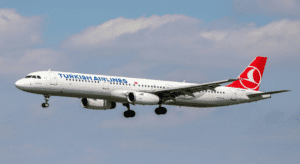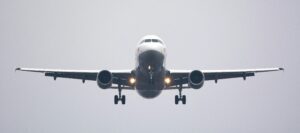In the vibrant era of the 1960s, a wave of independence swept across Africa. Nations, one after another, unfurled their flags of sovereignty, and with this newfound freedom, they sought symbols to represent their national pride and unity. For many, the answer lay in the skies—national airlines became emblems of independence, connecting people and cultures both within and beyond their borders.
Somali Airlines was born from this spirit of autonomy and was a beacon of hope and progress for Somalia, a country charting its course in a new world. It was not just about aircraft and destinations; it was about the aspirations of a nation. It reflected a time when Africa was redefining itself, and national carriers like Somali Airlines were more than just companies—they were a statement of identity and capability. The carrier was a symbol of connection, not just between cities but also between people and their dreams.
https://centreforaviation.com/data/profiles/airlines/somali-airlines
The Dawn of Somali Airlines
Somali Airlines, the once proud flag carrier of Somalia, was established on March 5, 1964, with the help of Alitalia. The airline was known for its “White Star Service,” and symbolized the aspirations of a newly independent nation and its commitment to connecting Somalia with the world.

The airline was a joint venture, with the Somali government and the Italian airline Alitalia each owning half. This partnership was not just financial but also technical, with Alitalia providing essential support during the airline’s formative years.
Somali Airlines began operations in July 1964, initially focusing on domestic routes before expanding internationally. The airline started with a fleet that included three Douglas DC-3s and two Cessna 180s. This inaugural flight marked the beginning of Somali Airlines’ journey as the national carrier, symbolizing the country’s aspirations and newfound independence.

The Golden Era
During its heyday, Somali Airlines boasted a diverse fleet including DC-3s, Fokker 27s, Airbus A310s, and Boeing 707s. It connected major cities like Mogadishu, Hargeisa, and Berbera domestically, and flew internationally to destinations such as Abu Dhabi, Jeddah, Rome, and Frankfurt. The airline was a source of national pride, being self-sufficient with its own trained pilots, engineers, and cabin crew.

The white Star services
The nickname “White Star Service” was a testament to the airline’s quality of service and its reputation among passengers. Somali Airlines was known for its hospitality and the professionalism of its staff, many of whom were trained in Germany through a technical cooperation with Lufthansa.
During its operational years, Somali Airlines was known for its commitment to service and connectivity. Compared to other carriers in the region, it held a unique position as the national flag carrier of Somalia, offering flights to both domestic and international destinations. This allowed Somali Airlines to stand out in a region where many countries were still developing their aviation industries.

How non Somali`s viewed the airline?
Non-Somalis generally viewed Somali Airlines as a reliable and hospitable carrier during its operational years. While specific testimonials from the period before the airline’s collapse in 1991 are scarce, historical accounts and retrospectives often highlight the airline’s commitment to service and its role in connecting Somalia with the rest of the world.
Here’s a general testimonial based on historical accounts:
“Somali Airlines represented both the pride and advancement of the nation. As someone who traveled internationally, I found the crew’s professionalism and hospitality impressive. The term ‘White Star Service’ wasn’t merely a label; it epitomized the exceptional experience provided. While flying above Somalia’s stunning landscapes, one could feel the country’s ambition and promise reflected in the airline’s service.”

Hijacking Incident
On November 24, 1984, a Somali Airlines flight en route from Mogadishu to Jeddah, Saudi Arabia, was hijacked by three heavily armed Somali soldiers named Awil Adami Burhan (the leader), Baashe Muuse Mohamed and Ahmed Haji Mohamed. The aircraft, a Boeing 707, Piloted by Captain Mohamoud Haji Elmi by known as Haji Dhagah, was carrying 130 persons when it was commandeered mid-air.
The hijackers were part of Somali National Movement (SNM) and their demands were politically motivated. They sought the release of political prisoners in Somalia and the stay of execution for seven young men who were scheduled to be executed for political reasons against the government of Somalia.
After redirecting the plane to Addis Ababa, Ethiopia, the hijackers threatened to blow up the aircraft along with the remaining hostages unless their demands were met. They initially set a deadline but later extended it, demanding that the seven individuals facing execution and an additional 13 political prisoners be flown to Djibouti.
The response from the Somali government
The Somali government, led by President Mohammed Siad Barre, denounced the act of “banditry and terrorism.”. The safety of the passengers and crew is the primary concern, and efforts are made to resolve the situation without loss of life. The political prisoners were released from the jail and hijackers released the hostages. The end was a win win situation.
The hijacking of the Somali Airlines flight in 1984 was a dramatic event that highlighted the political tensions within Somalia at the time. It also underscored the risks associated with civil aviation in conflict zones. The incident remains a significant event in the history of Somali Airlines and the region’s aviation sector.
Steps taken by the Somalia government to enhance the security after the hijack
After the hijacking incident involving Somali Airlines in 1984, the Somali government took several measures to enhance aviation security:
1. Strengthened Airport Security: The government implemented stricter security measures at airports across Somalia to prevent unauthorized access to aircraft and facilities. This included increasing the presence of security personnel, installing surveillance cameras, and conducting more thorough passenger screenings.
2. Improved Intelligence Gathering: There was a greater emphasis on intelligence gathering to identify potential security threats before they reached the airport. This involved collaboration between various intelligence agencies to monitor and assess security risks.
3. Enhanced Training for Aviation Personnel: Aviation personnel, including pilots, cabin crew, and ground staff, received additional training on security procedures and protocols. This training included how to recognize and respond to suspicious behaviour, as well as emergency response procedures in the event of a security threat.
4. Implementation of Crisis Management Plans: The government developed and implemented comprehensive crisis management plans for dealing with security incidents at airports. These plans outlined protocols for responding to hijackings, bomb threats, and other security emergencies, ensuring a coordinated and effective response.
5. Collaboration with International Partners: The Somali government worked closely with international partners, including neighbouring countries and international aviation organizations, to enhance aviation security. This collaboration involved sharing information, conducting joint training exercises, and coordinating security efforts to mitigate security threats.
6. Investment in Technology and Infrastructure: The government invested in upgrading technology and infrastructure at airports to enhance security capabilities. This included the installation of advanced screening equipment, surveillance systems, and access control measures to detect and deter security threats.
Overall, these measures aimed to strengthen aviation security in Somalia and mitigate the risk of future security incidents like the hijacking of Somali Airlines in 1984. By improving security protocols, enhancing training, and collaborating with international partners, the Somali government sought to ensure the safety and security of passengers, crew, and aircraft operating within Somali airspace.

Turbulence and Collapse
The onset of the civil war in the early 1990s was a devastating blow to the airline. The ensuing chaos led to the suspension of operations in 1991, marking the end of an era for Somali Airlines.
The civil war began in the late 1980s, leading to widespread chaos and instability. The airline’s operations were severely disrupted as the conflict escalated. The airline faced operational challenges as the maintenance of aircraft and infrastructure became increasingly difficult. In addition, the safety of passengers and crew could not be guaranteed amidst the conflict.
By 1991, the situation had deteriorated to the point where the airline could no longer function. The last flights were operated under harrowing conditions, with reports of flights being shot at and airports being in the midst of battle zones. The collapse of the central government led to the cessation of all international flights. The once-bustling airports stood empty, and the fleet was grounded indefinitely.
Personally, I wasn`t lucky (or old) enough to travel on it, but I met some of the airline’s management, crew and ground engineers; the ultimate people who made the carrier an international airline within a very short period of time.
Impact on the Aviation Sector
The collapse of Somali Airlines left a significant void in the region’s aviation sector. It took years for Somalia to re-establish a semblance of regular air service, primarily through private carriers.
Regional carriers like African Express Airways filled the void, profiting in the challenging market of Somalia. Later, other privately owned airlines such as Daallo Airlines, Damal Airlines, Star Airlines and Jubba Airways were launched to fill the gap left by the collapse of Somali Airlines. However, most of such airlines apart from Daallo have ceased operations. Daallo Airlines has faced a new competition from international carriers such as Turkish Airlines, Qatar Airways, Ethiopian Airlines, and flydubai as the security situation in Somalia improved.
Lessons from the Demise of Somali Airlines
Somalia can learn several valuable lessons from the history of Somali Airlines:
1. Importance of National Carriers: National carriers like Somali Airlines play a crucial role in promoting connectivity, national pride, and economic development.
2. Partnerships and Technical Support: The successful launch of Somali Airlines with the help of Alitalia shows the importance of strategic partnerships and technical support in establishing and running a national airline.
3. Government Ownership and Management: The transition to full government ownership in 1977 highlights the challenges and responsibilities that come with managing a national carrier.
4. Impact of Political Stability: The collapse of Somali Airlines during the civil war underscores the importance of political stability for the survival of national institutions.
5. Preparedness and Crisis Management: The airline’s struggle during the civil war emphasizes the need for robust crisis management plans to ensure continuity of operations during challenging times.
Revival Efforts
Despite its collapse, the legacy of Somali Airlines lives on. Efforts to revive the airline have been ongoing, reflecting the enduring spirit of the Somali people and their desire to see their national carrier take to the skies once again.
The question of whether Somalia needs a national carrier like Somali Airlines is multifaceted and depends on various economic, political, and social factors. A national carrier can significantly contribute to economic development by facilitating trade, tourism, and investment. Airlines often serve as a symbol of national pride and identity, representing the country on an international stage. A national airline can improve connectivity, providing direct flights that might not be commercially viable for foreign carriers. Establishing a national carrier can create jobs and build expertise in the aviation sector. Having a national airline can give a country more control over its transportation infrastructure, which can be crucial during times of crisis.
However, there are challenges such as the need for substantial investment, the risk of financial losses, and the competitive global aviation market. Ultimately, the decision to establish a national carrier would need to consider the specific needs and capabilities of Somalia, as well as the potential benefits and challenges involved.
Conclusion
Somali Airlines remains a symbol of hope and resilience. Despite its collapse, Somali Airlines remains a symbol of national identity and pride. Its story is a poignant reminder of the impact of conflict on national institutions and infrastructure. The airline’s story is one of resilience in the face of adversity, and its legacy continues to inspire hopes for a brighter future in Somali aviation. Its story is one of triumph and tragedy, reflecting the broader narrative of Somalia itself. As discussions about its revival continue, the airline stands as a reminder of what can be achieved and the potential that still exists for Somalia’s future in aviation.



